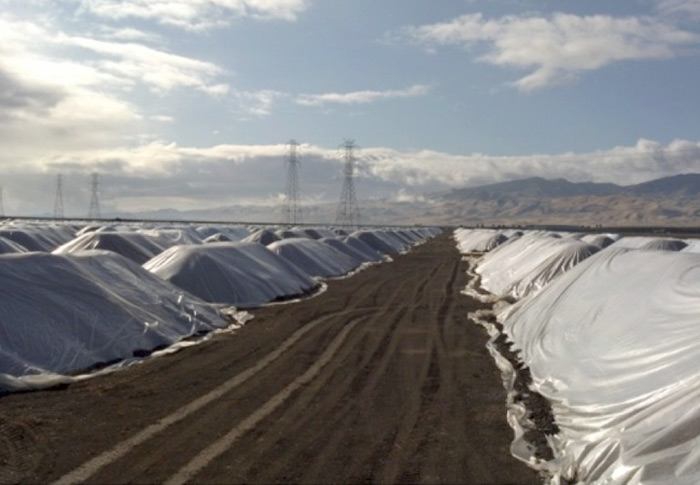
With the increase in almond plantings over the past few years, processing delays will become more common. While waiting to be processed, almonds are usually stockpiled. Stockpiling has a number of advantages, including getting the almonds out of the orchard sooner to allow the ability to perform post-harvest practices, reduce in-field insect infestations, and allowing greater flexibility in scheduling transport to the processor.
When stockpiling, make sure that the total moisture content (In-hull almond) is less than 9% (Hulls should snap when bent). Choose a location which is suitable for drainage in rainy weather and that is not near equipment or fuel storage. Stockpiles should be oriented in a north-south direction to aid in drying and covered with white-on-black tarps. These practices reduce humidity and day-to-night heat fluctuations, leading to a reduction in condensation. Monitor humidity and open the tarp when appropriate to reduce condensation and mold formation. Also monitor and treat for insect, bird, and rodent pests. If rain threatens, ensure piles are covered . Finally, be aware that stockpiles are a potential fire hazard.
Stockpiles should be fumigated to reduce insect infestation. NOW is an excellent storage pest and can survive in stockpile conditions. Furthermore, this pest can continue to feed and reproduce within stockpiles, increasing damage as well as aflatoxin risk. Although time consuming, fumigation is critical in killing larvae and eggs, reducing damage.
Finally, be wary of too much moisture in stockpiles. Studies have shown that hull moisture above 14% and a holding temperature greater than 120°F will increase the risk for concealed damage, mold, and aflatoxin. With an earlier harvest, stockpiles will be exposed to higher temperatures. If needed, delay harvest until nuts can dry. This will be increasingly necessary as orchard canopy coverage increases as cooler temperatures and more shade increases dry times. Avoid windrowing until nuts are close to the desired moisture level. If already in stockpiles, remove tarps during the day to dry and cover at night. This helps reduce the fluctuations in humidity, which lead to dew and mold growth.
If harvesting the later varieties in rainy conditions, keep the nuts in the tree if possible to aid in drying. If already on the ground, try to encourage drying by removing leaves, twigs, and other material. This may take several passes with the pick-up machine or conditioner.
More information on Dr. Lampinen’s and Dr. Michailides work on stockpiling can be found here.

